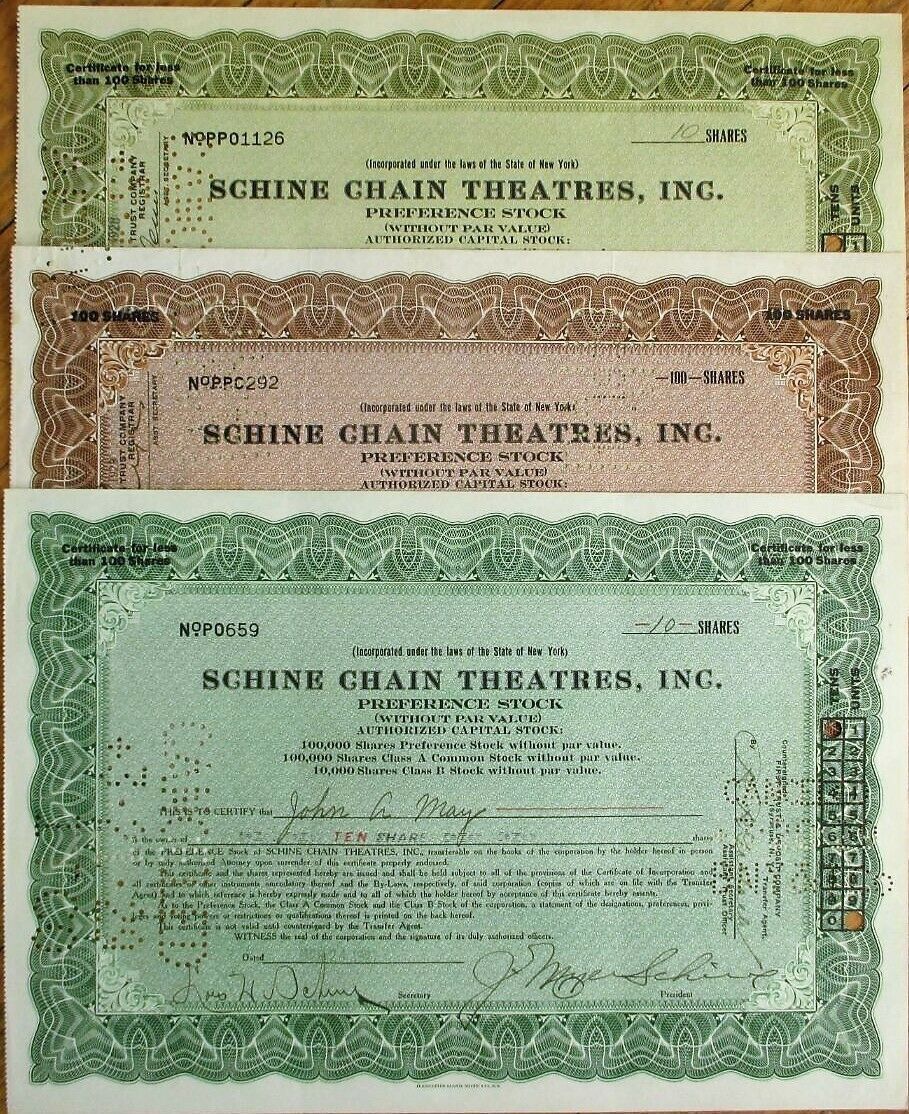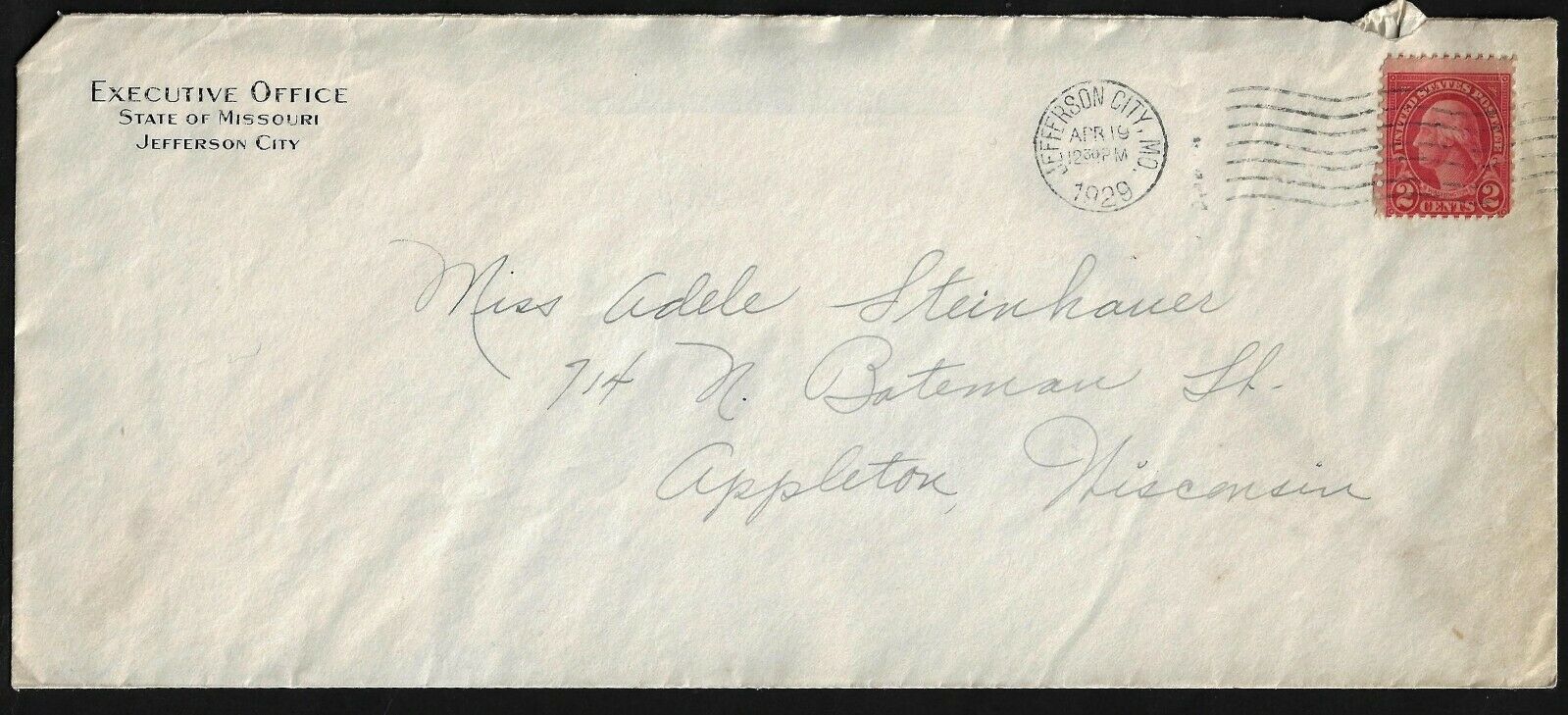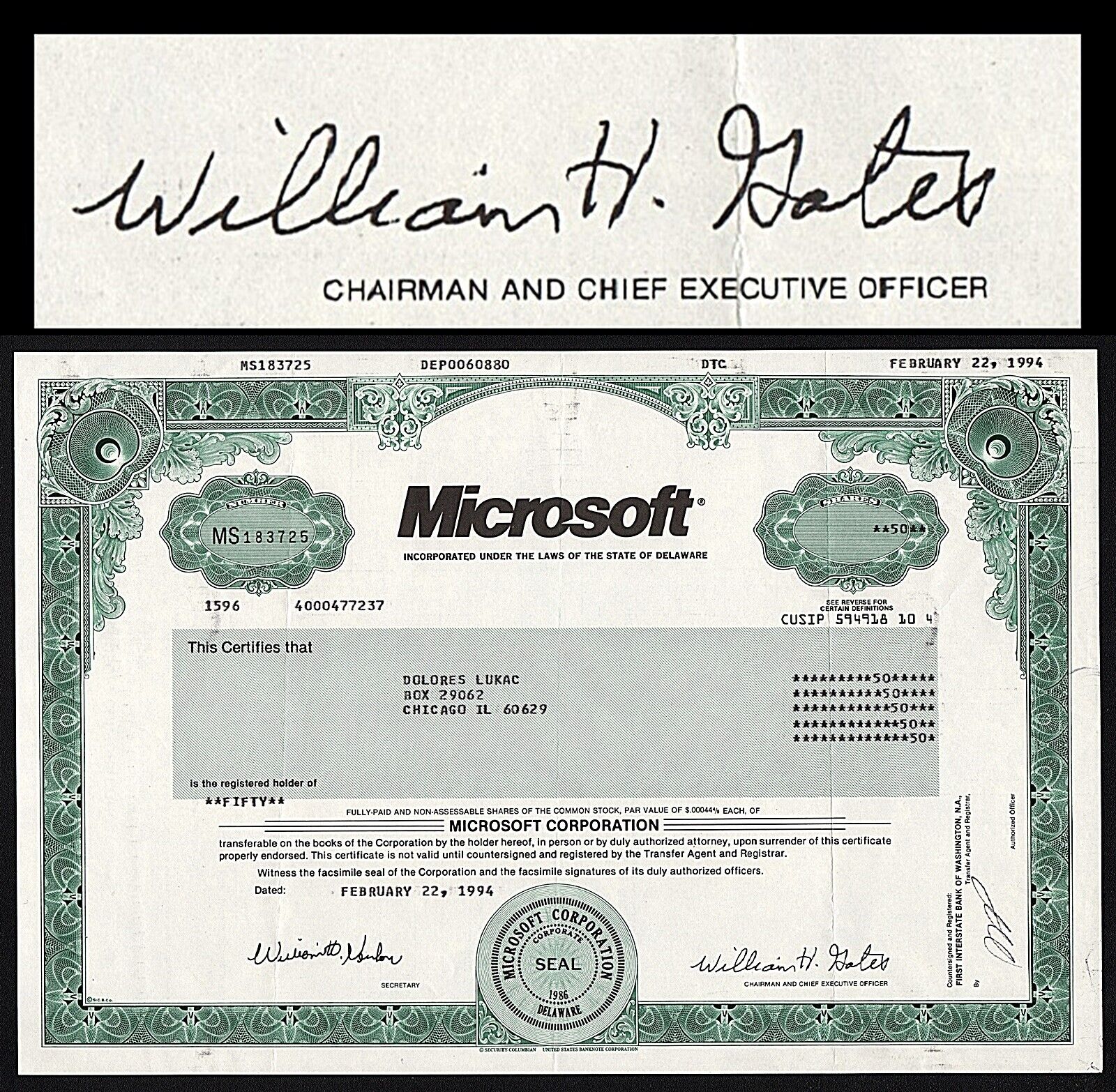-40%
Pine Creek Railway Company Bond Certificate Signed by Vanderbilt & DePew
$ 21.12
- Description
- Size Guide
Description
Product DetailsBeautifully engraved antique bond certificate from the Pine Creek Railway Company dating back to the 1880's. This document, which has been signed by Chauncey DePew and William K. Vanderbilt as Trustees, was printed by the American Bank Note Company, and measures approximately 15" (w) by 9 1/8" (h).
This certificate features three nice vignettes. A farmer with a sickle sits on a fence at the top left. Allegorical Justice appears at the upper right, and a train can be seen at the bottom.
Images
The images presented are representative of the piece(s) you will receive. When representative images are presented for one of our offerings, you will receive a certificate in similar condition as the one pictured; however dating, denomination, certificate number and issuance details may vary.
Historical Context
[ View all of our Pine Creek Railway Stocks & Bonds ]
On December 1, 1871, Sobieski Ross, one of the Jersey Shore, Pine Creek & Buffalo's promoters, wrote to George B. McClellan, extolling the advantages of the route. McClellan was then president of the Atlantic and Great Western Railroad, which shipped petroleum to New York City over the Erie Railway. The Erie's service was felt to be unsatisfactory, and the A&GW potentially interested in a new partner. The eastern end of the A&GW was at Salamanca, New York, about 35 miles from Port Allegany along the Allegheny River, and could easily be extended along the river to connect with the JSPC&B. At Newberry, near Williamsport, traffic could be routed onto the Catawissa Railroad and then the Central Railroad of New Jersey to reach the New York area.
Ross's letter gives a good idea of the route planned. He says that it would descend on the western side via Mill Creek, which meets the Allegheny River at Coudersport. The closest approach to the Pine Creek watershed would leave Mill Creek to climb along Nelson Run. A summit tunnel 2,300 feet long was planned, which would suffice to carry a line from the headwaters of Nelson Run into Splash Dam Hollow, then down Lyman Run to the West Branch Pine Creek, reaching the main stream of Pine Creek at Galeton.
Besides the JSPC&B's value as a trunk line, Ross hopefully anticipated the development of traffic along the line from lumbering, coal mining, and iron manufacturing. In the end, only lumbering and tanning would play a significant role in the industry of the area. The coal beds along the Allegheny River west of Coudersport were proclaimed "worthless" by the State Geological Survey in 1885, nor could the local iron ore deposits be economically worked.
While grading of the JSPC&B began on June 12, 1873, the Panic of 1873 soon brought a halt to construction. The unfinished line appeared in other grandiose rail schemes: the Gaines and State Line Rail Road, incorporated 1875, would have built north from the JSPC&B at Gaines as part of a line to Hornellsville and Geneva, New York.
During the early 1880s, the New York Central Railroad (NYC) and a consortium of coal companies from Tioga County, Pennsylvania and New York State embarked upon a bold venture. The coal companies were plagued by labor disputes, and the deposits they mined were diminishing. The NYC feared that its rival, the Pennsylvania Railroad, would use its control over coal shipments from central Pennsylvania to inflate the price of that fuel. The solution decided upon was that the coal companies, backed by the NYC, would build a new rail line into the Clearfield Coalfield and open new mines there. Coal would move north over the new line to the NYC. The JSPC&B would be a key link in the new extension. It would also link the NYC to its ally, the Philadelphia and Reading Railroad, via the latter's Catawissa Railroad subsidiary at Newberry.
Gaining control of the JSPC&B, the NYC exploited a provision of the railroad's charter allowing for branches of up to thirty miles in any county traversed by the main line. The new connection would leave the Corning, Cowanesque and Antrim Railroad at Stokesdale Junction, near Wellsboro, and follow Marsh Creek to Pine Creek and the original route at Ansonia, and then pass downstream to Jersey Shore and the Reading connection at Newberry.
The remainder of the grading was sold off, and in fact was the first part of the route to operate: the Coudersport and Port Allegany Railroad opened on the old grade between the two towns in its name in 1882. The JSPC&B continued construction on the route from Newberry to Stokesdale Junction, which ran through the spectacular Pine Creek Gorge (also known as the Grand Canyon of Pennsylvania) below Ansonia. The new line began regular service on June 4, 1883 and was opened over its whole length on July 1, 1883. However, the New York Central did not choose to operate the JSPC&B directly. On December 18, 1882, it was leased to the Fall Brook Coal Company from the date of completion (officially June 30, 1883) for twenty years. The company's name was changed to the Pine Creek Railway on February 6, 1884.
As the Pine Creek Railway, the new line formed an important part of the Fall Brook's system. The Fall Brook already leased the Corning, Cowanesque & Antrim and a series of NYC-controlled lines in New York, giving it a continuous line from Tioga County to the NYC main line at Lyons, New York. On July 1, 1892, the Fall Brook Coal Company separated its railroad and coal interests, transferring the Pine Creek Ry. lease to the new Fall Brook Railway. However, the independent operation of these lines by the Fall Brook was not to last. In 1895, the NYC began to investigate buying out the Fall Brook, which now formed a vital link between the New York Central main line and the NYC-controlled Beech Creek Railroad at Jersey Shore. The NYC ultimately succeeded in buying up the Fall Brook Railway, and took over the Pine Creek Railway lease on May 1, 1899. On February 4, 1909, the Pine Creek was merged with other elements of the former Fall Brook system to form the Geneva, Corning and Southern Railroad, which in turn was merged into the New York Central on December 22, 1914.
William Kissam Vanderbilt
William K. Vanderbilt's Signature
William Kissam Vanderbilt I was born on December 12, 1849. His father was William Henry Vanderbilt. His paternal grandfather was Cornelius Vanderbilt.
Vanderbilt inherited million (equal to about .5 billion today). from his father. He managed his family railroad investments. In 1879, after taking over P. T. Barnum's Great Roman Hippodrome which was on railroad property by Madison Square Park, he renamed the facility Madison Square Garden.
Vanderbilt was one of the founders of The Jockey Club. He was a shareholder and president of the Sheepshead Bay Race Track in Brooklyn, New York and the owner of a successful racing stable. In 1896, he built the American Horse Exchange at 50th Street (Manhattan) and Broadway. In 1911 he leased it (and eventually sold it to) the Shubert Organization who then transformed it into the Winter Garden Theatre.
Like other Vanderbilts, he built magnificent houses. His residences included Idle Hour (1900) on Long Island and Marble House (1892), designed by Richard Morris Hunt, in Newport, Rhode Island. Hunt also designed Vanderbilt's 660 Fifth Avenue mansion (1883).
Vanderbilt was a co-owner of the yacht Defender, which won the 1895 America's Cup and briefly owned the large steam yacht Consuelo. Vanderbilt was a founder and president of the New Theatre. He was also a member of the Jekyll Island Club aka The Millionaires Club.
Vanderbilt made significant charitable contributions to Vanderbilt University, a private university in Nashville, Tennessee named for his grandfather.
Chauncey DePew
Chauncey DePew's Signature
Chauncey Mitchell Depew (April 23, 1834 – April 5, 1928) served as a United States Senator from New York from 1899 to 1911.
Depew read law with William Nelson of Peekskill, New York from 1856-58; was admitted to the bar in March, 1858; and practiced in Peekskill until 1861; later engaged in the brokerage business in New York City as member of firm of Depew & Potter for a few months; then resumed his law practice in Peekskill, but shortly afterwards moved to New York City; member of New York Assembly 1861-63, serving as chairman of Ways and Means Committee during his second term and as speaker pro tern, for a part of the session; Secretary of State of New York 1863-65; in 1865 appointed and confirmed United States Minister to Japan, but declined the appointment; became attorney for New York & Harlem Railroad 1866 and for New York Central and Hudson River Railroad 1869; appointed general counsel and director of the so-called "Vanderbilt System" 1876; made second vice president of New York Central & Hudson River Railroad 1882, and served as president 1885-1898; had since been chairman of board of directors of New York Central Railroad Company; had also been president of West Shore Railroad; director of New York and Harlem Railroad Company since 1874, Chicago and North Western Railway and Chicago, St. Paul, Minneapolis and Omaha Railroad companies since 1879, Cleveland, Cincinnati, Chicago and St. Louis Railroad Company since 1889 Delaware and Hudson Railroad Company since 1892, W. Union Telegraph Company since 1881, New Jersey Junction Railroad, St. Lawrence and Adirondack Railroad, Walkill Valley Railroad, and Canada Southern Railroad companies, Hudson River and Niagara River Bridge companies, New York State Realty & Terminal Company, Union Trust Company, Equitable Life Assurance Company, and Kensico Cemetery Association; regent of University of the State of New York 1877-1904.
DePew was one of the commissioners appointed to build the state capitol 1874; in 1867 appointed clerk of Westchester County by Governor Fuller, but resigned after a short service; made immigration commissioner by New York Legislature in 1870, but declined to serve; member of boundary commission of the state of New York in 1875; had also been commissioner of quarantine and president of Court of Claims of New York City and commissioner of taxes and assessments for the city and county of New York; defeated for Lieutenant Governor of New York on Liberal Republican ticket in 1872; candidate for United States senator in 1881, but withdrew after the fortieth ballot, declined nomination as a senator in 1885, but elected to the Senate in 1898 and served from March 4, 1899, to March 3, 1911; stumped the state of New York for John C. Fremont in 1856 and for Lincoln in 1860; delegate-at-large to Republican National conventions 1888-1904 and delegate to all following conventions, including 1928, being elected the day before he died; made the nomination speeches for Harrison in 1892, Governor Morton in 1896, and Fairbanks in 1904; at the convention in 1888 received ninety-nine votes for the presidential nomination, and in 1892 declined an appointment as Secretary of State in Harrison's cabinet; Adjutant of the 18th Regiment, New York National Guard, which served in the American Civil War, and later Colonel and Judge Advocate of the 5th Division, on the staff of Major General James W. Husted of the New York Guard, trustee of Peekskill Military Academy; president of New York State Society of the Sons of the American Revolution, of The Pilgrims from 1918 until his death, of the St. Nicholas Society, and of the Union League for seven years (member since 1868 and elected honorary life member at the close of his presidency); an officer of the French Legion of Honor; vice president of New York Chamber of Commerce 1904-08 (member since 1885).
He was a member of Yale Corporation 1888-1906; member of the Yale Alumni Association of New York at the time of its organization in 1868, its third president (1883-1892), and one of the incorporators of the Yale Club of New York in 1897; a vice chairman of the ,000,000 Yale Endowment Campaign; made LL D. Yale 1887; elected an honorary member of Yale Class of 1889 in 1923; By the terms of his will, a bequest of ,000,000 was left to Yale without restrictions as to its use.
He was made an honorary member of Columbia chapter of Phi Beta Kappa in 1887; member of citizens' committee of the civic organization to complete the Cathedral of St. John the Divine in New York City; in 1918 gave a statue of himself to Peekskill and ten acres of land for an extension of Depew Park, which he gave to the village in 1908. He was also a distinguished orator and after-dinner speaker; author: Orations and After Dinner Speeches (1890), Life and Later Speeches (1894), Orations, Addresses and Speeches (eight volumes) (1910), Speeches and Addresses on the threshold of Eighty (1912), Addresses and Literary Contributions on the Threshold of Eighty-two (1916), Speeches and Literary Contributions on the Threshold of Eighty-four (1918), My Memories of Eighty Tears and Marching On (1922); Miscellaneous Speeches on the Threshold of Ninety-two (1925); contributed a My Autobiography" in 1922, and an article to the 50th Anniversary Supplement of the Tale Daily News entitled "An Optimistic Survey" in 1928; member Metropolitan Museum of Art, American Association for the Advancement of Science, Society of Colonial Wars, Connecticut Society of the Society of the Cincinnati, Holland Society, Huguenot Society, New England Society, France-America Society, New York Historical Society, St. Augustine (Fla.) Historical Society, American Scenic and Historic Preservation Society, National Horse Show, Lafayette Post of the G. Al R , and St. Thomas' (Episcopal) Church, New York; made life member of Lawyers' Club of New York in 1918; honorary member New York Genealogical and Biographical Society.
His father, Isaac Depew, was a merchant and farmer; pioneer in river transportation between Peekskill and New York; son of Abraham Depew, who served in the Revolutionary Army, and Catherine (Crankheit) Depew, great-grandson of Captain James Cronkite of the Continental Army; descendant of Frangois DuPuy, a French Huguenot, who came to America about 1661, settled first in Brooklyn, N. Y., and in 1685 bought land from the Indians at the present site of Peekskill. Mother, Martha Minot (Mitchell) Depew; daughter of Chauncey Root Mitchell, a lawyer, and Ann (Johnstone) Mitchell; granddaughter of the Rev. Justus Mitchell (BA 1776); great-granddaughter of the Rev. Josiah Sherman (B A. Princeton 1754, honorary M.A. Yale 1765), who served as a Chaplain with rank of Captain in the Revolutionary War and the brother of American founding father Roger Sherman; descendant of Matthew Mitchell, who came to Boston from England in 1635, descended also from Capt. John Sherman, an English officer, who was born in Dedham, Essex County, in 1615, and from the Rev. Charles Chauncey (B.A. Trinity College, Cambridge, 1613), who came to Plymouth in 1637 and was the second president of Harvard.
When Chauncey Depew died, he was buried in Peekskill. In his honor, the huge concourse of Grand Central Terminal was draped in mourning.












